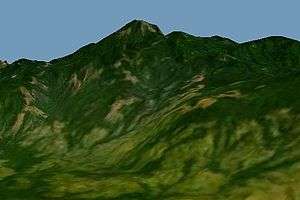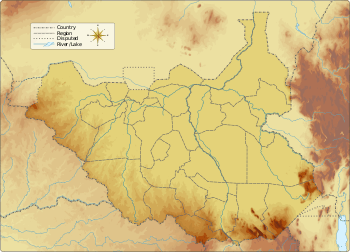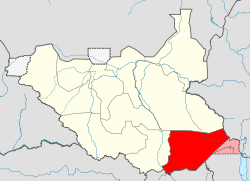Kinyeti
Mount Kinyeti is the highest peak in South Sudan. It is located in the Imatong Mountains in Ikwoto County of Imatong State, near the Ugandan border. It was earlier located in Eastern Equatoria before the reorganisation of states. Kinyeti has an elevation of 3,187 metres (10,456 ft) above sea level.[1] The group of high mountains that contain Kinyeti, extending to the border with Uganda, are sometimes called the Lomariti or Lolobai mountains.[2]
| Kinyeti | |
|---|---|
 | |
| Highest point | |
| Elevation | 3,187 m (10,456 ft) |
| Prominence | 2,120 m (6,960 ft) |
| Listing | Country high point Ultra |
| Coordinates | 3°56′51″N 32°54′32″E |
| Geography | |
 Kinyeti Location in South Sudan | |
| Location | South Sudan |
| Parent range | Imatong Mountains |
The lower parts of the mountain were covered with lush forest.[3] These are the most northern forests of the East African montane forest ecoregion.[4] The summit is rocky, with montane grassland and scattered, low ericaceous scrubs, low subshrub and herbs in rock crevices.[5] One of the first Europeans to visit the mountain was the botanist Thomas Ford Chipp, who discovered Coreopsis Chippii near the summit.[6]
References
- "Mount Kinyeti". Encyclopædia Britannica. Retrieved 2011-07-06.
- Kaj Vollesen (1998). Flora of the Sudan-Uganda border area east of the Nile, Part 1. Kgl. Danske Videnskabernes Selskab. p. 9. ISBN 87-7304-297-8.
- Paul Clammer (2005). Sudan: the Bradt travel guide. Bradt Travel Guides. p. 5. ISBN 1-84162-114-5.
- "East African montane forests". Terrestrial Ecoregions. World Wildlife Fund. Retrieved 2011-07-06.
- Kaj Vollesen (2005). Flora of the Sudan-Uganda border area east of the Nile: Catalogue of vascular plants, 2nd part, vegetation and phytogeography, Part 2. Kgl. Danske Videnskabernes Selskab. ISBN 87-7304-318-4.
- Earl Edward Sherff (20 October 1936). "Revision of the Genus Coreopsis" (PDF). Field Museum of Natural History, Chicago.
